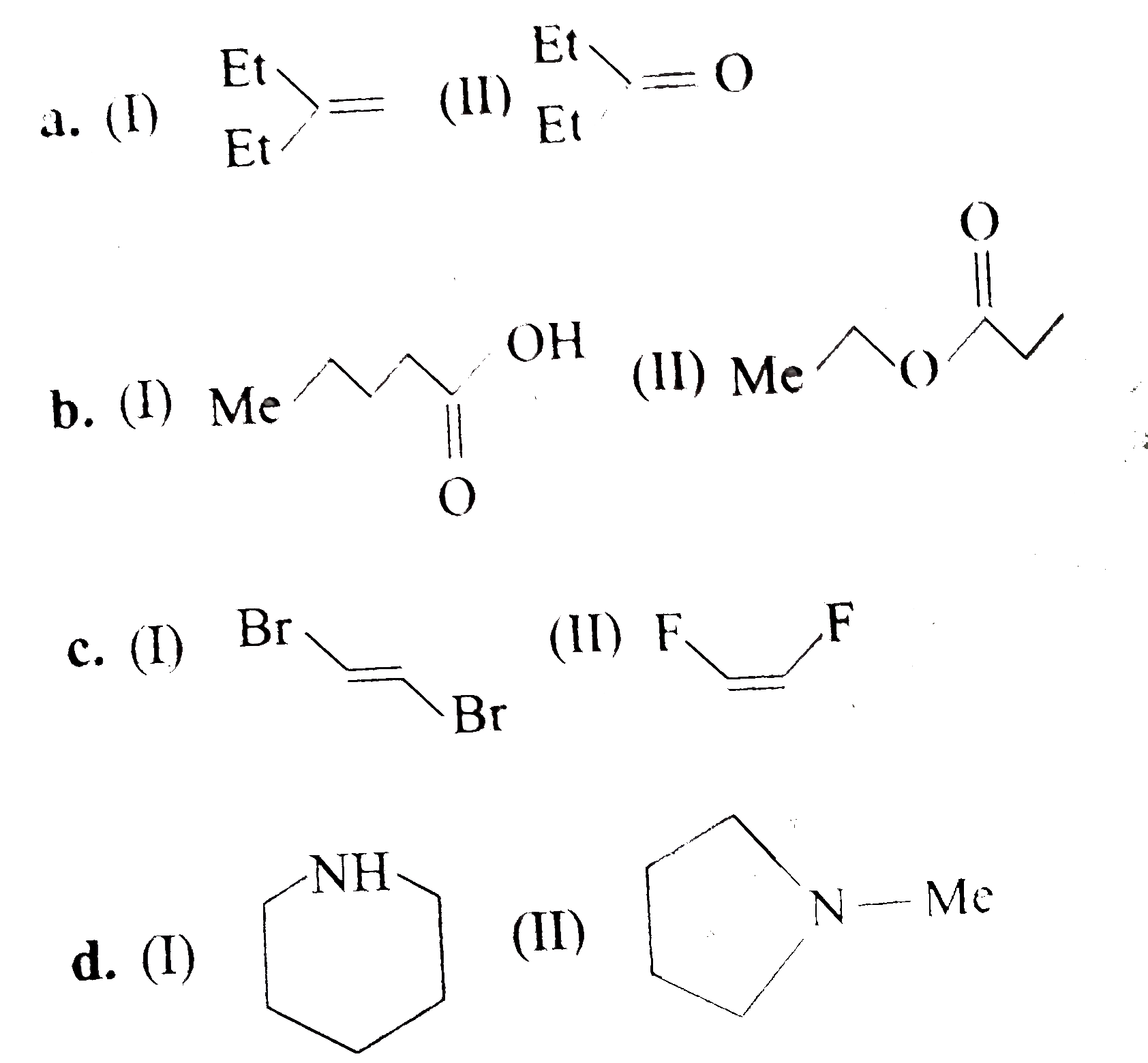State reasons for the following:
Primary amines have higher boiling points than tertiary amines.
To explain why primary amines have higher boiling points than tertiary amines, we can break down the reasoning into several steps:
1. Definition of Amines:
- Amines are organic compounds that contain a nitrogen atom bonded to carbon atoms. They can be classified as primary (RNH2), secondary (R2NH), or tertiary (R3N) based on the number of carbon groups attached to the nitrogen.
2. Hydrogen Bonding:
- Primary amines have two hydrogen atoms attached to the nitrogen atom (RNH2). These hydrogen atoms can participate in hydrogen bonding with other amine molecules or with water molecules.
- Tertiary amines, on the other hand, have three carbon groups attached to the nitrogen atom (R3N) and do not have any hydrogen atoms attached to nitrogen. This means they cannot form hydrogen bonds.
3. Extent of Hydrogen Bonding:
- The presence of two hydrogen atoms in primary amines allows them to form extensive intermolecular hydrogen bonds. This results in stronger interactions between the molecules.
- In contrast, tertiary amines lack the ability to form hydrogen bonds due to the absence of hydrogen atoms on the nitrogen. Therefore, they rely on weaker van der Waals forces for intermolecular interactions.
4. Boiling Point Implications:
- The stronger the intermolecular forces (like hydrogen bonding), the more energy (in the form of heat) is required to break these interactions when the substance is heated. As a result, primary amines, which can form strong hydrogen bonds, have higher boiling points.
- Tertiary amines, with their weaker intermolecular forces, require less energy to break the interactions, leading to lower boiling points.
5. Conclusion:
- In summary, the higher boiling points of primary amines compared to tertiary amines can be attributed to the ability of primary amines to form extensive hydrogen bonds due to the presence of hydrogen atoms on the nitrogen, while tertiary amines lack this capability.
- Amines are organic compounds that contain a nitrogen atom bonded to carbon atoms. They can be classified as primary (RNH2), secondary (R2NH), or tertiary (R3N) based on the number of carbon groups attached to the nitrogen.
- Primary amines have two hydrogen atoms attached to the nitrogen atom (RNH2). These hydrogen atoms can participate in hydrogen bonding with other amine molecules or with water molecules.
- Tertiary amines, on the other hand, have three carbon groups attached to the nitrogen atom (R3N) and do not have any hydrogen atoms attached to nitrogen. This means they cannot form hydrogen bonds.
- The presence of two hydrogen atoms in primary amines allows them to form extensive intermolecular hydrogen bonds. This results in stronger interactions between the molecules.
- In contrast, tertiary amines lack the ability to form hydrogen bonds due to the absence of hydrogen atoms on the nitrogen. Therefore, they rely on weaker van der Waals forces for intermolecular interactions.
- The stronger the intermolecular forces (like hydrogen bonding), the more energy (in the form of heat) is required to break these interactions when the substance is heated. As a result, primary amines, which can form strong hydrogen bonds, have higher boiling points.
- Tertiary amines, with their weaker intermolecular forces, require less energy to break the interactions, leading to lower boiling points.
- In summary, the higher boiling points of primary amines compared to tertiary amines can be attributed to the ability of primary amines to form extensive hydrogen bonds due to the presence of hydrogen atoms on the nitrogen, while tertiary amines lack this capability.
Topper's Solved these Questions
- BOOK - AAKASH INSTITUTE ENGLISHCHAPTER - AMINES EXERCISE - ILLUSTRATION2videos
AMINES
- BOOK - AAKASH INSTITUTE ENGLISHCHAPTER - AMINES EXERCISE - Try Yourself10videos
AMINES
- BOOK - AAKASH INSTITUTE ENGLISHCHAPTER - ALDEHYDES, KETONES AND CARBOXYLIC ACIDS EXERCISE - Try Yourself20videos
ALDEHYDES, KETONES AND CARBOXYLIC ACIDS
- BOOK - AAKASH INSTITUTE ENGLISHCHAPTER - BIOMOLECULESEXERCISE - EXERCISE (ASSIGNMENT) SECTION - D Assertion - Reason Type Questions5videos
BIOMOLECULES
Similar Questions
Account for the following
(i)Primary amines (R−NH2) have higher boiling point than tertiary amines (R3N)
(ii) Aniline does not undergo Friedel - crafts reaction
(iii) (CH3)2 NH is more basic than (CH3)3N in an aqueous solutionView SolutionWhy amines have higher boiling points than corresponding alkanes ?
View SolutionWhich of the following pairs would have higher boiling points ?
 View Solution
View SolutionGive explanation for each of the following :
(i) Why are amines less acidic than alcohols of comparable molecular masses ?
(ii). Why do primary amines have higher boiling points han tertiary amines ?
iii. Why are aliphatic amines stroner bases than aromatic amines ?View SolutionHow many of the following are tertiary amines ?
 View Solution
View SolutionTertiary amines have lowest boiling points amongst isomeric amines because
View SolutionWhich of the following is a primary amine .?
View SolutionState reasons for the following:
Aliphatic amines are stronger bases than aromatic amines.View SolutionCarboxylic acids have higher boiling points than aldehydes, ketones and even alcohols of comparable molecular mass. It is due to their
View SolutionAcids have much higher boiling points than isomeric esters because :-
View Solution

